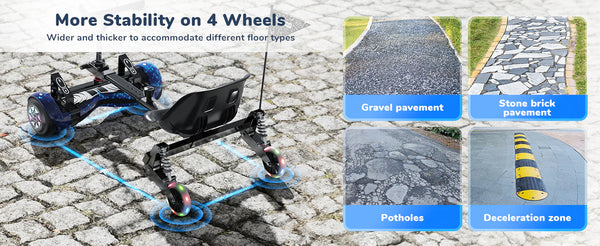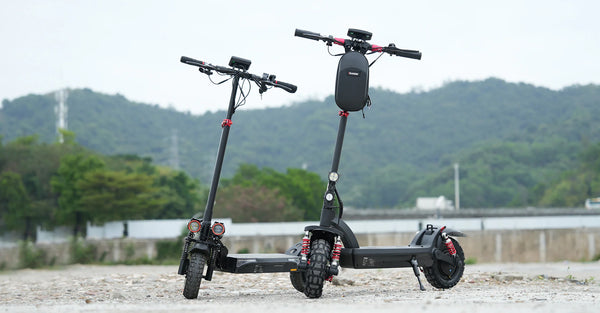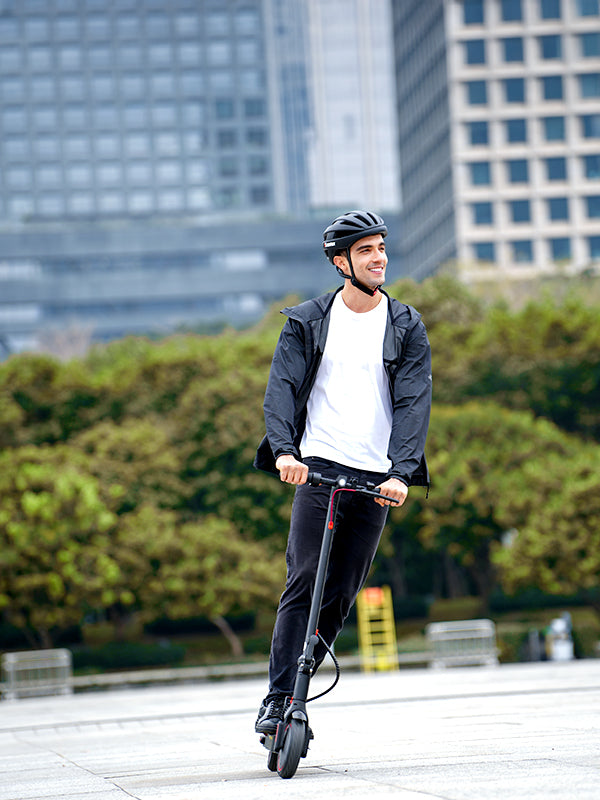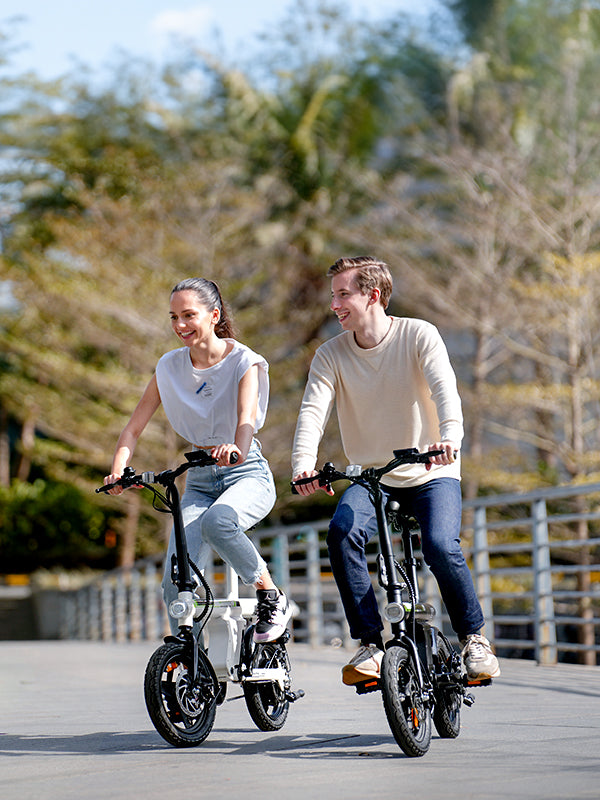
How to Kickstart an Electric Scooter?
Electric scooters have quickly become one of the most popular modes of transportation in urban areas. They’re fun, environmentally friendly, and cost-effective. However, if you're new to electric scooters or just purchased one, you might be wondering:
- How do I get this thing started?
While some electric scooters start automatically with a press of a button, many models require a manual push-off to engage the motor—a process known as kickstarting.
We would like to walk you through the steps of kickstarting your scooter, troubleshoot common problems, and share some essential safety and maintenance tips.
How your electric scooter's starting mechanism works?
Before diving into the "how-to," it’s essential to understand why kickstarting is necessary for some electric scooters.
Manual kickstart vs. Automatic start systems
There are two main types of electric scooters when it comes to starting mechanisms: those that require a kickstart and those with a fully motorized start. Kickstart models need a little push from the rider to engage the motor, while fully motorized versions start by pressing a button or twisting the throttle, much like a motorbike.
Kickstarting is often designed to preserve battery life. The initial push gets the scooter moving before the motor takes over, which helps prevent unnecessary energy usage during low-speed starts. Additionally, it acts as a safety feature, ensuring the motor doesn't engage accidentally when the scooter is stationary.
Why some scooters require kickstarting
Kickstarting is common in many entry-level scooters as a power-saving measure. When a scooter is moving at a certain speed—usually around 2-3 mph—the motor engages, reducing the strain on the battery. This makes the scooter more efficient in terms of power consumption, extending both battery life and overall ride range.

Fg: iScooter i8 Electric commuter Scooter
Preparing your scooter for kickstarting
Before you start riding, it’s crucial to get your scooter ready. Here’s how.
Check the battery level
The first and most important thing to check before attempting to kickstart your scooter is the battery level. A low or dead battery will prevent the scooter from functioning. Most scooters have a battery indicator on the dashboard or near the handlebars. Make sure the battery is charged to at least 20% to ensure smooth operation.
Inspecting the scooter before you start
Take a minute to inspect your scooter before each ride. Start with the tires, checking for proper inflation and any signs of wear. Move on to the brakes, ensuring they’re responsive and functional. Finally, inspect the lights, handlebars, and the deck to make sure everything is in good condition. A quick pre-ride check can prevent accidents and breakdowns.
Turning on the power
Once your scooter is ready, turn on the power. The power button is typically located on the handlebar or near the scooter’s deck, depending on the model. In some scooters, you may need to insert a key, while others may have a keyless start. Ensure the scooter is in the correct mode (eco, standard, etc.) for your riding style, as some scooters may limit power in eco mode.
Step-by-step guide on how to kickstart an electric scooter
Now that your scooter is powered up and ready to go, it's time to learn how to kickstart it. Follow these steps carefully for a smooth start:
✅Step 1: Position the scooter
Start by positioning yourself on the scooter correctly. Place one foot firmly on the scooter deck, right in the center. Your other foot should remain on the ground, ready to push off. Make sure you have a stable, comfortable stance, as balance is key when kickstarting.
✅Step 2: Power up
With your scooter turned on, make sure the motor is in the mode that allows kickstarting (this is usually the default mode). If there’s a display, check for any icons or signals indicating that the scooter is ready for a manual start. Make sure the throttle is in its neutral position to avoid a sudden jolt when the motor engages.
✅Step 3: Push off to kickstart
The key to a successful kickstart is to generate enough initial speed for the motor to take over. To do this, give the scooter a gentle push off the ground with the foot that's on the ground. You don’t need to push too hard—just enough to get the wheels rolling at around 2-3 mph. The motor won’t engage unless the scooter is in motion, so this step is crucial.
✅Step 4: Engage the throttle
Once you’re moving, it’s time to engage the motor. Slowly twist the throttle (or press it, depending on your scooter model). Don’t slam the throttle all the way—this can cause the scooter to lurch forward unexpectedly. Instead, gradually increase the throttle as you gain balance and speed. You’ll feel the motor kicking in smoothly after your initial push.
✅Step 5: Ride smoothly
Now that the scooter is in motion, focus on maintaining your balance and controlling the speed. Keep your hands firmly on the handlebars and look ahead to ensure a smooth, safe ride. Adjust your speed using the throttle and make sure to slow down when approaching obstacles or corners.

Troubleshooting common kickstarting issues
Even with the best preparation, you might run into some problems when trying to kickstart your scooter. Here are the most common issues and how to fix them:
✔ Scooter won’t start: what to check
If your scooter doesn’t start, the first thing to check is the battery. If the battery is low, charge it for at least an hour before attempting to start again. If the battery is fine but the scooter still won’t engage, there might be an electrical issue. Inspect the power cables, looking for any loose connections or signs of damage.
✔ Brake locks
Some electric scooters have a safety feature that locks the brakes to prevent the motor from engaging while stationary. Check if the brakes are locked, and if so, manually disengage them before trying again.
✔ Motor engagement problems
If your scooter moves but the motor doesn’t engage, it could be due to a faulty motor controller. Double-check that the scooter is in the correct mode for kickstarting. If it’s still not working, consult your scooter’s manual or contact customer support for assistance.
Read more: Can I fix the electric scooter motor by myself?
Safety tips before and during kickstarting
Safety should always come first when riding an electric scooter. Here are a few tips to ensure you stay safe while kickstarting and riding:
Wearing protective gear
Before kickstarting, make sure you’re equipped with the proper safety gear. A helmet is non-negotiable, as it can protect your head in the event of a fall. Knee and elbow pads are also recommended, especially for beginners. If you plan on riding at night or in low-light conditions, wear high-visibility clothing or reflective gear.
Starting on smooth surfaces
As a beginner, practice kickstarting on flat, smooth surfaces such as parking lots or quiet streets. Avoid busy roads, uneven terrain, or areas with lots of pedestrians while you’re learning. Starting on smooth surfaces will help you gain confidence and prevent any unnecessary falls.
Check your surroundings
Always check your surroundings before kickstarting. Make sure there are no obstacles in your path, and be mindful of pedestrians, cyclists, and vehicles. Clear paths and smooth surfaces make for a safer and more enjoyable ride.

Kickstarting for beginners
If you’re new to kickstarting, give yourself time to practice and get comfortable with the process. Learning how to balance on a scooter takes practice, and it’s okay to feel a bit wobbly at first.
Finding your balance
When riding, keep your feet shoulder-width apart on the deck and distribute your weight evenly between both feet. Grip the handlebars firmly, but avoid over-tightening your grip as this can affect your control of the scooter.
Learning curve: practicing kickstarting safely
It’s best to practice kickstarting in a low-speed mode, such as eco mode, where the motor is less sensitive. This will allow you to focus on balancing and controlling your speed without the risk of sudden acceleration. With practice, you’ll find kickstarting becomes second nature.
Maintaining your scooter for easy kickstarts
Keeping your scooter well-maintained will ensure it remains easy to kickstart and runs smoothly over time.
Regular battery maintenance
Maintaining the health of your scooter’s battery is key to avoiding start-up problems. Charge the battery after each ride, and avoid letting it drain completely. If you store your scooter for long periods, make sure to recharge the battery periodically to prevent degradation.
Lubricating mechanical components
To ensure smooth operation, keep the scooter’s mechanical parts well-lubricated. This includes the wheels, motor, and throttle mechanism. A few drops of lubricant every few months will keep everything moving freely and reduce wear and tear.
Check for wear and tear
Inspect your scooter regularly for signs of wear and tear. Check the tires, brake pads, and cables to ensure everything is in good condition. Replacing worn-out parts in time will prevent more serious damage down the road.
Conclusion
Kickstarting an electric scooter might seem tricky at first, but with the right technique and a bit of practice, it becomes a simple and efficient way to get moving. Not only does it preserve battery life, but it also ensures a smooth start every time. Remember to prioritize safety, practice in low-risk environments, and maintain your scooter to keep it in top shape.
Happy riding!
Product Category
Recent Posts

Up to 50% Off! Our Black Friday 2024 Event Is HERE!

Best Hoverboard with Seat: K3 Hoverboard Go-Kart Guide!

Go-Kart: The Complete Guide to Hoverboard with Seat

Electric Scooter Wheels: Solid Tires vs Pneumatic Tires




















































Still, need help? Contact Us: support@ihoverboard.com
What's the option? Check out the option now!
Leave us a message